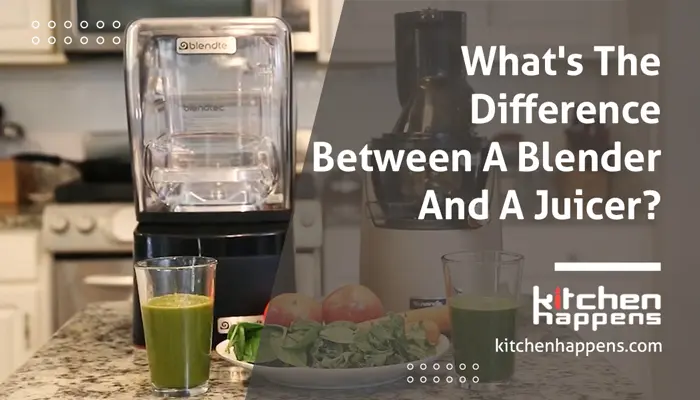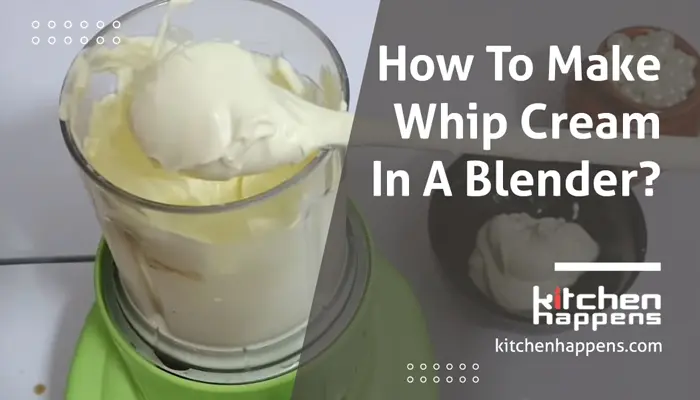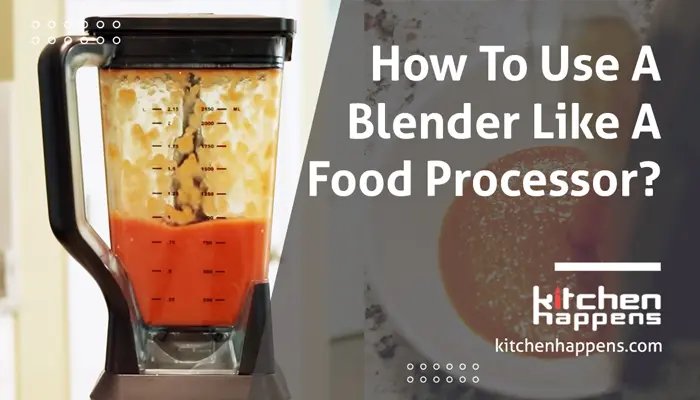Do you have a misconception that juicing and blending are the same?
Well, I don’t know about you, but I have seen many people think of these two processes as similar.
Just like the process, the two machines, the blender, and the juicer are also different.
And I know exactly what makes you come across this writing.
Since you want to know, what’s the difference between a blender and a juicer, I will give you the answer in a descriptive way.
So, after going through my whole write-up, you will be able to understand their variation, as well as which one is more worth buying.
First of all, let’s learn what these two appliances are.
What’s A Blender?
A blender is also known as a mixer or liquidizer. It’s a kitchen appliance used to puree, crush, or emulsify food as well as other substances.
As the name suggests, a blender can blend any type of food you will put inside. A stationary blender includes a container with a rotating blade at the bottom and is powered by an electric motor placed in the base.
Blenders are excellent for making fruit and vegetable smoothies as their sharp blades efficiently transform the components into tasty drinks. They preserve all of the fiber in the contents, assisting natural digestion and preventing constipation.

Some powerful models are able to crush ice and other frozen foods. Speaking of the newer immersion blender, they have a motor on top connected by a shaft to a spinning blade at the bottom. And you can use it with any container.
Now, that you have a clear conception of blenders, how about knowing their types.
Explore the next segment for details.
Types of Blender
There are various different types of blenders available in the market for purchase. Usually, you will find three types of blenders: Countertop Blenders, Personal Blenders, and Immersion Blenders.
Get to know them one by one from here.
1. Countertop Blender:
These types of blenders can range from standard to advanced ones. Standard ones are great for basic needs. For instance, if you want to crush ice and make smoothies or pie fillings, these are a great choice.
On the other hand, the advanced ones that are high-powered blenders come with pre-set programs. They have the ability to heat ingredients, and their powerful motors can break down various tougher ingredients.
A 1–2 liter (4–8 cup) blending container composed of glass, plastic, or stainless steel is used in countertop blenders. Glass blenders are more stable and heavy, while plastic is easily scratched and absorbs the odors of mixed foods.
Nowadays, stainless steel is more famous for its appearance. However, you won’t be able to see the food while it is being blended.
2. Personal Blender Or Portable Blender:
A miniature version of a traditional blender, these handy gadgets let you blend a drink and carry it with you in the same jar. Also, you can produce a tiny batch of your favorite blender recipe.
You can take these portable blenders anywhere and blend your favorite ingredients on the go.
3. Immersion Blender:
The hand-held immersion blender, also known as a hand blender, stick blender, or wand blender, doesn’t have its own container. Instead of that, it has a mixing head with whirling blades that you can immerse in a container to mix foods.
Immersion blenders are useful for homogenizing volumes that are too large to fit in the bowl of a stationary blender or are too hot to be securely put into the bowl, as in the case of soups.
Okay, it’s time to move on to the juicer.
What’s A Juicer?
A juicer is also known as a juice extractor. It extracts juice from fruits, herbs, leafy greens, and other types of vegetables.
The pulp is crushed, ground, and/or squeezed to extract the juice. The juice results in a thin, concentrated liquid is often low in fiber but high in essential nutrients.
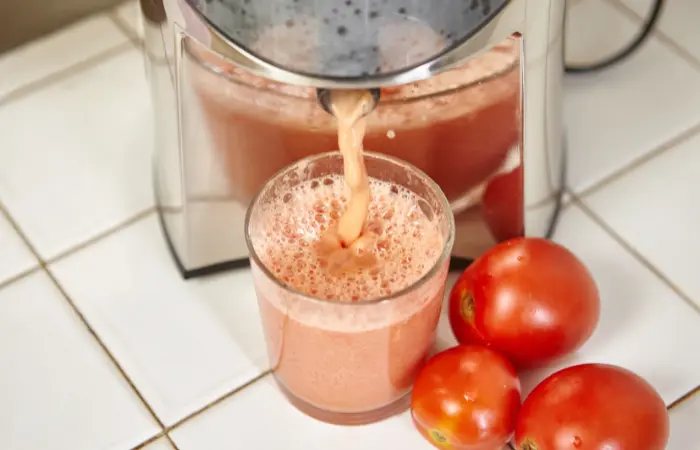
Types of Juicer
Commonly, there are two types of juicers, Centrifugal and Masticating juicers.
1. Centrifugal Juicer:
Centrifugal juicers extract juice by pressing the ingredients against a strainer with a rotating metal blade. The juice is then poured into a waiting container, leaving the pulp behind for disposal.
One of the drawbacks of these types of juicers is that their blade produces heat which may destroy the enzymes of your fruit. In short, the juice will contain fewer nutrients.
2. Masticating Juicer:
Masticating juicer is also called a cold press juicer. If you want to make nutrition-packed juice, these are what you need.
It presses and crushes the ingredients to extract the juice. By the way, with these, the juicing time will be longer. It’s because they are efficient at keeping all the important nutrients.
Also, masticating is lagers and more expensive than centrifugal juicers. And they create less heat too. Learn the difference between masticating and centrifugal juicers.
Alright, it’s time to learn the variance between a juicer and a blender.
A Competitive Discussion on What’s The Difference Between A Blender And A Juicer
The key difference between a juicer and a blender is how they process the fruit and vegetables. As I said, a juicer will extract the juice from fruits and vegetables by crushing, grinding, or squeezing the liquid out of the pulp, leaving just the thin juice and none of the fiber left.
In contrast, a blender does not separate your ingredients rather; it blends all of them together for a thicker consistency.
From here, I will compare them depending on various attributes.
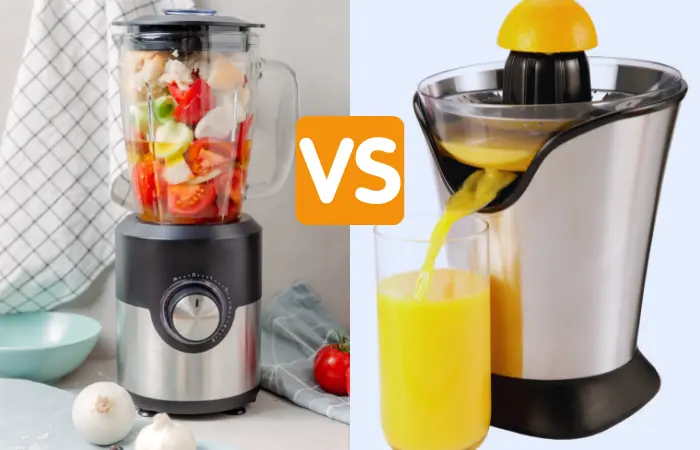
Benefits of Using A Blender
The advantages of using a blender are as below.
- No waste: Since a blender processes everything that you put inside, there is no fibrous pulp to dump at the end. So, if you are concerned about any waste, then a blender is better to choose.
- More energetic: The drink’s fiber delays digestion, allowing energy to be released gradually and evenly. This helps reduce sugar highs and lows and makes you feel fuller for longer after drinking it.
- Helps with digestion: The fiber from fruits and vegetables sweeps your digestive system clean, acting as a cleanser. This aids in the removal of pollutants and promotes your regular discharge.
- Variety of uses: With a blender, you can make more than just juices and sauces. A good can handle harder ingredients. You can chop ingredients like ice cream and nuts and make fresh nut milk from scratch.
- Time saver: A blender relieves you of a lot of labor and ensures that you can prepare a highly healthy, nutritious meal in just a few minutes. In most cases, you don’t have to cut ingredients. Just put and press the button, and you will be rewarded with a mixture for use in your dish immediately.
The Downside of Blender
- Heat reduces the number of nutrients: Blenders generate heat through their fast-spinning blades, which might lower the number of nutrients in your mixture.
- Noisy: Blenders are typically noisy while they process foods.
By the way, there are some quiet blenders available in the market. They use vibration-dampening technology and sound blockage that covers the container.
Benefits of Using A Juicer
The advantages of using a juicer are not any less than a blender, and they are as follows.
- Quick absorption: After you extract the juice from your fruit or veggies, the indigestible fibrous pulp is left behind. Therefore, your body can easily absorb the vitamin and mineral-packed juice, and the goodness of the drink will go straight where you need it.
- Holds more nutrients: Because the juicing removes a lot of the bulk from your drink, you can pack many more vitamins and nutrients into the same-sized glass.
- Easy to digest: Since all the fiber has been removed, the liquid of the juice is gentle on your digestive system. Hence, if you have any digestive problems, this can be an excellent method to rest your system while still getting all of the nutrients you need.
The Downside of Juicer
- Food waste: Juicing leaves loads of fruit and vegetable fibers, leading to waste.
- Limited Drinks: In a juicer, you can’t add ingredients other than vegetables and fruits, which means you are limited in the types of drinks you can make.
- Not so filling: As juices don’t contain fiber, they are not so filling to the stomach.
Okay, till now, I have given you some straight information about these two kitchen gadgets. But, from now on, things are going to heat up as the battle of juicer vs blender, which is the better choice, is starting.
And first, I will let you know which is the healthier option.
Which Is Healthier?
As you already know that juicing is wasteful and lacks fiber, you may assume that it’s a less nutritious product than blended smoothies. But is it true?
Well, absolutely not. The truth is that both blending and juicing have several health benefits.
For instance, one study on juicer vs. blender nutrient contents found that blending whole fruits preserves more antioxidants and helpful compounds. And on the other hand, juicing fruits can extract more vitamin C.

Another review of studies revealed that juices of fruit and vegetables provide a large number of antioxidants and anti-inflammatory mixtures that are able to help protect against heart disease.
Again, I would like to mention that to make the same amount of juice as you get in a smoothie, you have to use a larger collection of produce. Hence, juices often hold a more concentrated number of nutrients compared to blended smoothies. In addition, your body can absorb nutrients in juices rapidly.
In contrast, smoothies may provide extra health benefits because of the presence of fiber. Moreover, the nutrients of smoothies are digested more slowly. So, it provides a more consistent supply of energy.
In short, both of them are nutritious in their own way.
Juicing Vs. Blending: Which Is Better for Losing Weight?
Well, who doesn’t want to lose weight, right?
And I guess you jumped right into this section if you are on a journey of shedding some pounds of your body.
You know that sugar is the enemy of most diets. While fruits are healthy in moderation, eating too many of them might raise blood sugar levels. Because the juice provides the majority of the sweetness in a fruit, it’s easier to reduce the amount you consume when blended because the pulp and other components weigh it up.
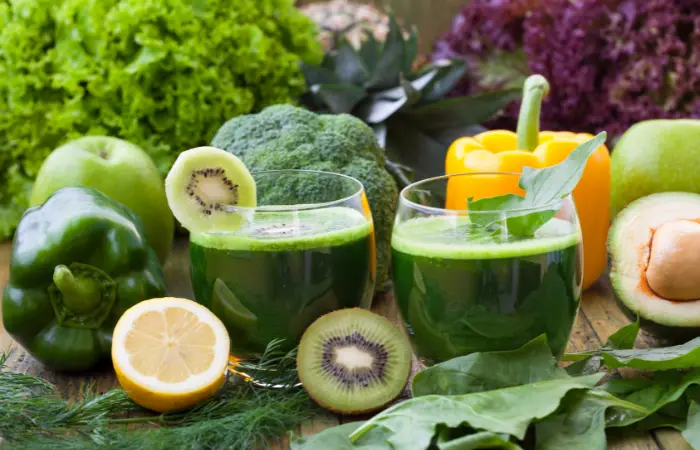
Some commercial fresh juices have the same amount of sugar as sodas, if not more. Fruit juices contain 45.5 grams of fructose per liter on average, according to a 2014 study, which is similar to the 50 grams per liter found in sodas.
Although smoothies also contain calories, still it’s less than juices.
Thus, when it comes to choosing between juice or blended smoothies for weight loss, the blender is definitely a better option.
Which One Is Easy to Use?
To use a blender, you need to add your ingredients and can start immediately. But, juicers require monitoring, and you have to add one piece of fruit or veggie at a time.
So, it’s evident that you have to stand by the juicer and keep putting pieces to make juice. While on the other side, you don’t need to monitor the blender. Therefore, you can do other house chores when your ingredients are getting ready.
Shortly, a blender is a bit easier to use.
Which One Is Easy to Clean?
When you can place most of the blenders into the dishwasher, finding a juicer that doesn’t need hand washing is hard.
Even depending on the size of the juicer, cleaning them gets tricky. It’s because juicers come with strainers and other sensitive attachments that necessitate proper scrubbing to get rid of the built-up pulp, particles, and odors. And most of these parts are not safe to put in dishwashers.
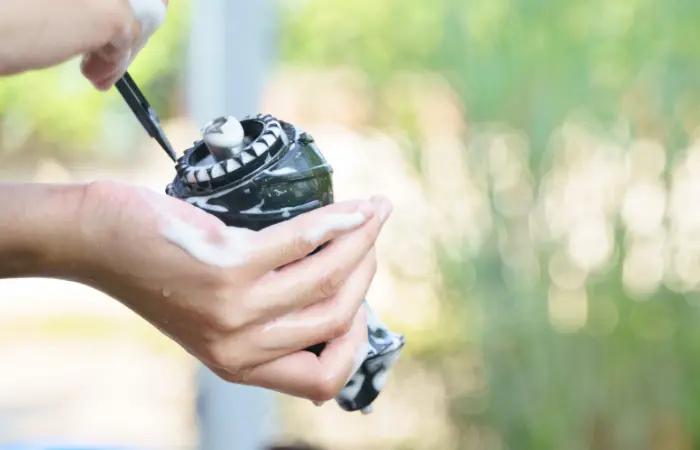
In a word, blenders are easier to clean as they don’t come with several parts as a juicer.
So, blender wins in this segment too. Now, let’s see whether it can keep the crown for the next section.
Difference in Taste
First, I want to clarify that it’s down to personal preference regarding taste.
Personally, I believe that juicers provide a superior drinking experience than the blenders for most drinks. Just think about celery juice made in a blender or juicer. Which one will you prefer?
Although it’s never tasty, drinking a glass of celery juice is far easier than blended celery, which has all the pulp and fiber.
This is also true of most fruits. However, some fruits, such as bananas, cannot be juiced.
But, of course, not everyone is a fan of juice. And you may also like the taste of smoothies better than juices.
Can You Use A Blender As A Juicer?
Just imagine that your blender can do the job of a juicer; wouldn’t it be great?
Yes, in that way, you don’t even have to pay for two kitchen tools. And the good news is that you can make juice with a blender.
Along with a good blender, you will need a nut milk bag/ a cheesecloth/ a napkin, and a bowl.
To make the juice, simply combine your fruits and vegetables with some water in a blender, then pour the liquid through the nut milk bag on top of a bowl. Squeeze the juice with your hands until it’s all in the bowl.
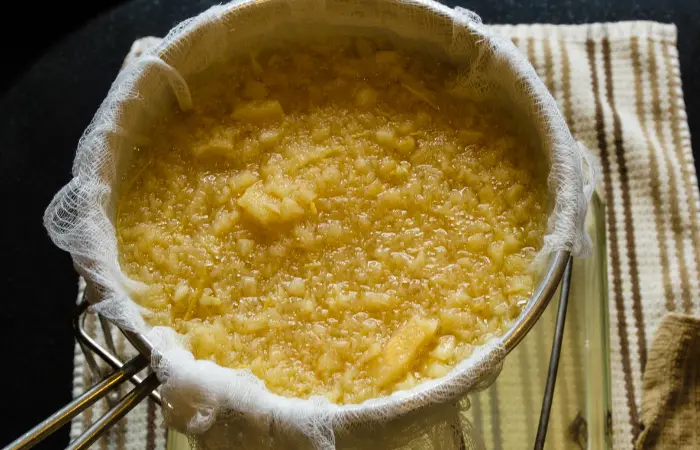
However, remember that this juice made from blenders won’t have the thin consistency you get from a juicer. So, if you have a juicer, it’s better to use it. And the above method is suggested when you don’t have one.
Which One Is Cheap: Blender Or Juicer?
Well, the price of blenders and juicers varies a lot depending on brands, models, and available features.
Although you can find a juicer at a reasonable price, it’s still difficult to find them at the same low prices as a blender. It’s because juices not only blitz fruits and veggies but also remove the pulp, making them more innovative machines.
So, if you are on a tight budget and want fresh, healthy drinks, you may opt for a blender. Also, you will easily find some excellent portable blenders that aren’t expensive.
You can buy a good blender for under $100, but a decent juicer will cost between $100 to $500 range.
Even though you can find a cheap juicer, it’s not always recommended unless you are sure about the quality. I have experience with some low-priced juicers; I can assure you that most of them can’t even do the job properly.
So, in terms of cost-effectiveness, a blender is the better option.
Blender Vs. Juicer: Which One Should You Choose to Buy?
Just like many other debates, there is no correct answer that will fit everyone’s needs. First of all, you have to decide on your preference.
A blender may be the ideal option if you enjoy smoothies and want to improve your digestive health by consuming more fiber.
On the contrary, a juicer is a great alternative if you want fresh juices to improve your energy and nourish your body rapidly with tons of vitamins, minerals, and antioxidants.
Moreover, you need to consider your budget too.
In summary, you may choose to buy one over the other based on your dietary or digestive problems, a tight budget, or a simple preference for one sort of drink over the other.
And if you ask for my recommendation, I will say that a well-equipped kitchen should have both a juicer and a blender.
Alright, as we are at the edge of today’s discussion, it’s time to share my final words on the juicer vs. blender: what’s the difference topic.
Final Verdict
After going through my whole write-up, I hope you have thoroughly learned about what’s the difference between a blender and a juicer, their health benefits, cost, and which one is most suited for you to buy.
Although they have several differences, they fulfill their purposes in a good way.
Both come in various price ranges, so you will be able to choose one that meets your demands and pocket. However, bear in mind the types of recipes you’d like to prepare since this will influence whether you need a more powerful machine or not.
Hopefully, you enjoyed the time with me while learning all the facts. Lastly, be healthy and stay happy.
Goodbye…

